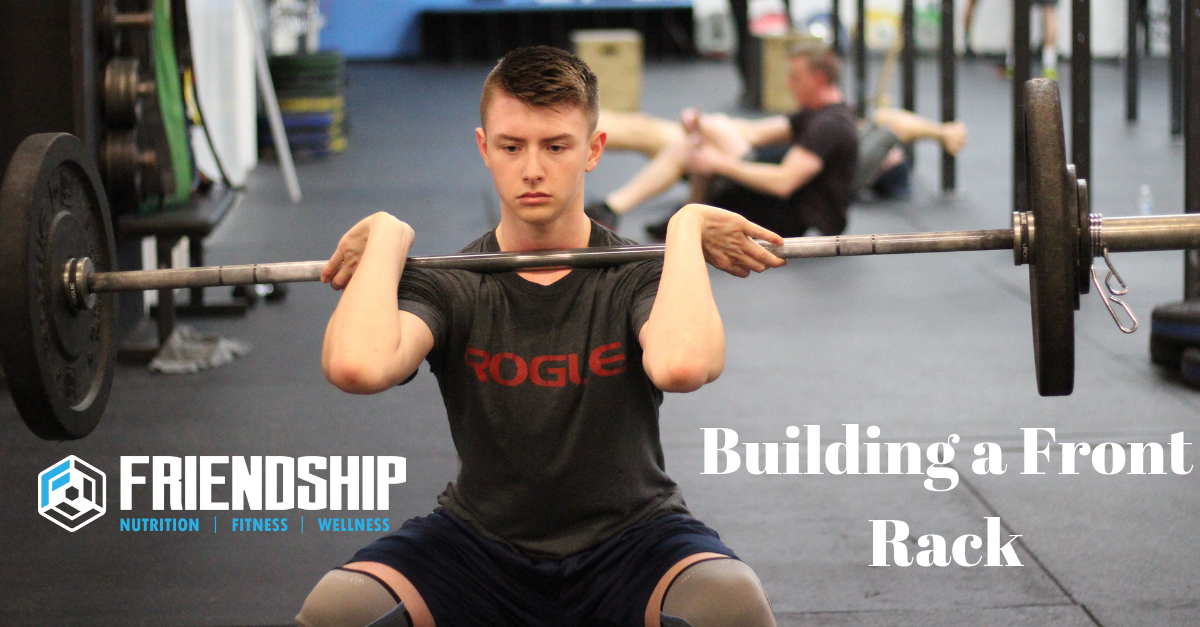Building a Front Rack: A Major Posture & Performance Improvement
Written by Coach Eric Cross
Front Rack Mobility
With the squat cycle beginning at Friendship and the start of the Benchmark/Open cycle, I wanted to share some thoughts on how to improve our squat efficiency, more specifically the front squat (as well as other front rack related movements; jerks, thrusters, etc.). As you know the squat is a fundamental movement and plays a big role in what we do in life, but also in the gym whether it is part of the conditioning or the strength portion. The front, back and overhead squat are vastly different movements with different mobility & strength requirements, even though they are all squats. They each use and rely on different muscles to make a successful lift, so that’s what we want to focus on and help with in this article. If you're able to improve these positions you will find you're able to breathe better in the workouts and lift more efficiently, safely and more weight in the strength portion!

To make the front squat successful, both in form and making the lift, you will need excellent mobility from the wrists, to the T-spine (upper back) all the way down to the ankles. It is very rare for people to have this mobility walking in the door, thus is it something we need to train. I think it is very important to understand how our body works and why we fail lifts in these positions, so let’s break the front rack down piece by piece and body part by body part.
Thoracic Spine (T-Spine):
The T-spine is all of your upper back and the part of your body that’s tends to “fail” first when one does a front squat. The upper back tends to round (#MashedPOTATOES) or “fail” when driving out of the bottom of a squat. That could be caused either by a lack of strength, or a lack of mobility - but it is most likely a combination of both. This is one of the most common problems we see, and also is generally a hard area to improve!
For a deep dive into the anatomy of this check out this video from KStar.
Shoulders:
Loosening up:
The shoulders are are tied with the T-spine. The more mobile and stable your T-spine is, the better shoulder position you will have (higher front rack). But at the same time the shoulders themselves require a good amount of mobility & rotation to make a good front rack position. If our shoulder and T-Spine position breakdown, we'll run into more issues with our wrists and other stability/mobility problems!
Lets go over some ways we can improve that mobility in the shoulders and t-spine: Starting off pretty basic is foam rolling, I know it’s not everyone's favorite, but it's necessary. Starting with the lats, t- spine and shoulders. We do a lot of thoracic openers and rotations to begin our classes, hopefully you've taken note of a few you can add into your warm-ups! Hitting each area will allow these muscles to loosen up and allow for a better position. If you’re someone who struggles with the front rack in general, I would recommend you do this each day you're in the gym.
Next we’ll show some more stretches you can do:



Stabilizing:
Hand-in-hand with the mobility of the Front Rack position is how well you can STABILIZE it! I can not express this enough, it is important you have the mobility to complete these next exercises, working on them without the proper mobility could hinder your progress by repeatedly drilling (and thus strengthening) a bad position. (Cue Jenny "it's not okay to do bad")
Like we said in the beginning, the places we see the least stability is in the upper and lower back, and a weak core and T-spine will result in a failed lift and continued poor form. All of the exercises are a part of a progression, and will mostly focus on strengthening the T-spine as well as the core. Once you feel you’ve become proficient in one, move to the other or add weight.
Now here are some exercise to build up that stability:






Conclusion:
As with any training, this should be included in as your accessory work and be done with the right intent. If you’re someone who struggles with this position, we highly recommend that you add some time outside of class or at home to build better posture and position. Rome wasn’t built in a day, be patient and continue to work on your weaknesses - Your posture AND your workouts will thank you!

